If there’s one thing that’s pretty much guaranteed to ruin a good photo, it’s being out of focus. Not surprisingly, then, I get lots of questions about autofocus settings whenever I’m teaching photography. Of course, those settings don’t just change between different models of cameras, but across different manufacturers as well. Having just covered the AFC championship between the Chiefs and Bills last Sunday night, alongside some of the best photographers in the business, I decided to ask them to share some tips for how they use autofocus with the various cameras they’re shooting. After all, if those work well for pro football, they should work well for birds in flight or kids running around the backyard too!
Let’s start with Jamie Squire, one of Getty Images’ premier sports photographers. Most of his work is actually done outside of Kansas City, as they send him to major sporting events all over the world. But when he’s home, you can find him working Royals and Chiefs games. Getty provides their photographers with Canon equipment, and Jamie normally works with three cameras and lenses covering the Chiefs. Here’s what he had Sunday night for the championship:
Canon EOS R5 with 200-400mm f/4 Canon lens and built in 1.4 teleconverter
Canon EOS 1DX Mark II with 70-200 f/4 Canon lens
Canon EOS 1Dx Mark II with 16-35 f/2.8 Canon lens
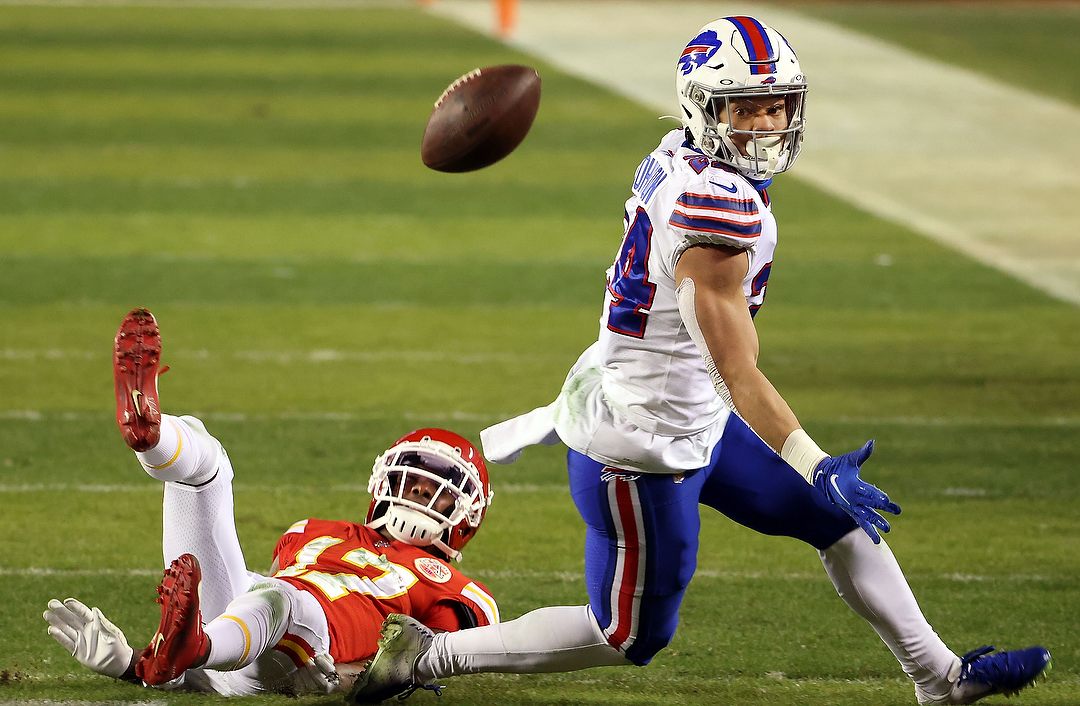
Buffalo Bills cornerback Taron Johnson breaks up a pass intended for Kansas City Chiefs wide receiver Mecole Hardman. Photo by Jamie Squire/Getty Images.
His primary camera these days is the EOS R5 (one of Canon’s mirrorless models). “I adjust the AF Setting to Case #4 (for subjects that accelerate or decelerate quickly), then dial the tracking sensitivity down 1 step so the AF stays locked better on the subject in case something comes between me and them.” He uses back-button focus and has the autofocus set to AI Servo (continuous). “The AF method I choose is Face tracking with eye detection enabled and continuous AF disabled, and the initial Servo AF point set for the center point.” He goes on to explain why he sets up the camera this way. “When I go to use AF, I put the center AF point on the subject I want, then push the back button. The AF point locks onto the subject and will then follow it around the frame. It’s amazing, almost like cheating.” His other two cameras are also set for Case #4 AI Servo with the AF point in the center. Setting all of his cameras to work the same way makes it easy for him to grab and shoot.
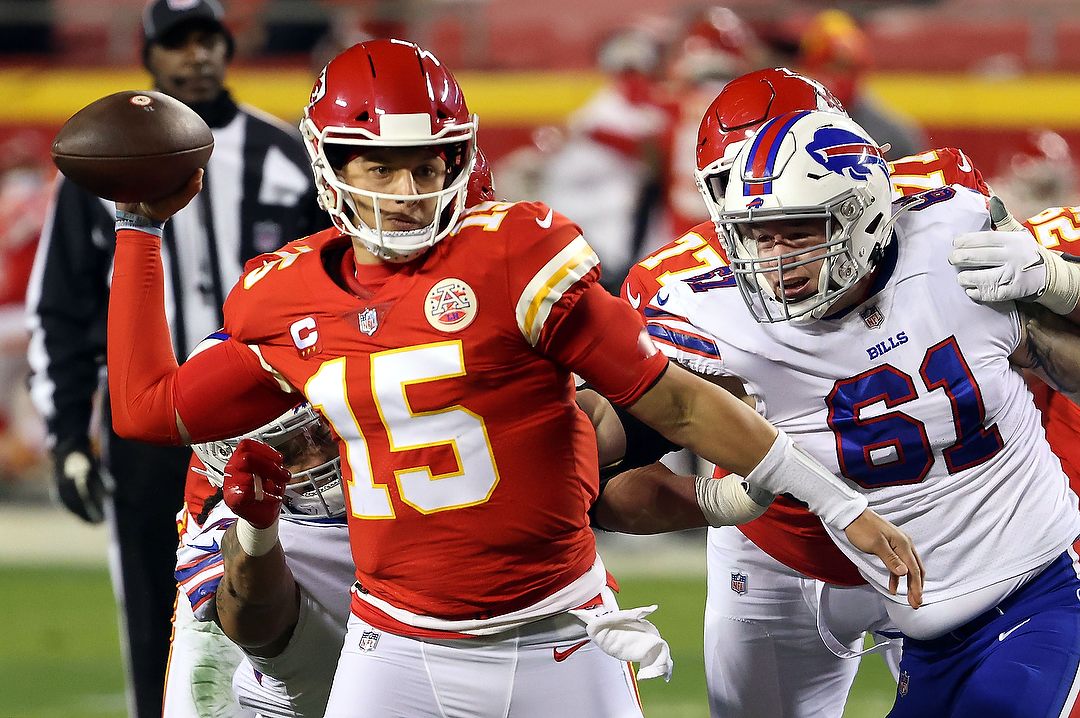
Kansas City Chiefs quarterback Patrick Mahomes is chased by Buffalo Bills defensive tackle Justin Zimmer. Photo by Jamie Squire/Getty Images.
I should add that Jamie normally shoots football with either the Canon 400mm f/2.8 or Canon 500mm f/4 lenses, which give him shallower depth of field than the 200-400. But on Sunday night he was covering the championship by himself, so the flexibility of the 200-400 became more important. If you’d like to see more of Jamie’s work, you’ll find it on Getty’s website.
Next up are two Kansas City Star photographers who covered the Chiefs through last year’s Super Bowl and have followed them all this season as well.
Tammy Ljungblad has been with the Star longer than she’d like me to tell you, doing everything from fashion to news to sports as well as working the editor’s desk. She’s been covering the Chiefs this season with two bodies and three lenses:
Nikon D4s with Nikkor 400mm f2.8 lens and a 1.4 teleconverter. Or, the Nikon 500 f/4 lens and a 1.4 teleconverter (2.8 lens primarily for the night games).
Nikon D4s with a Nikkor 70-200mm 2.8 lens.
She also carries a Nikkor 24-70mm 2.8 lens in case she needs a wide-angle view.
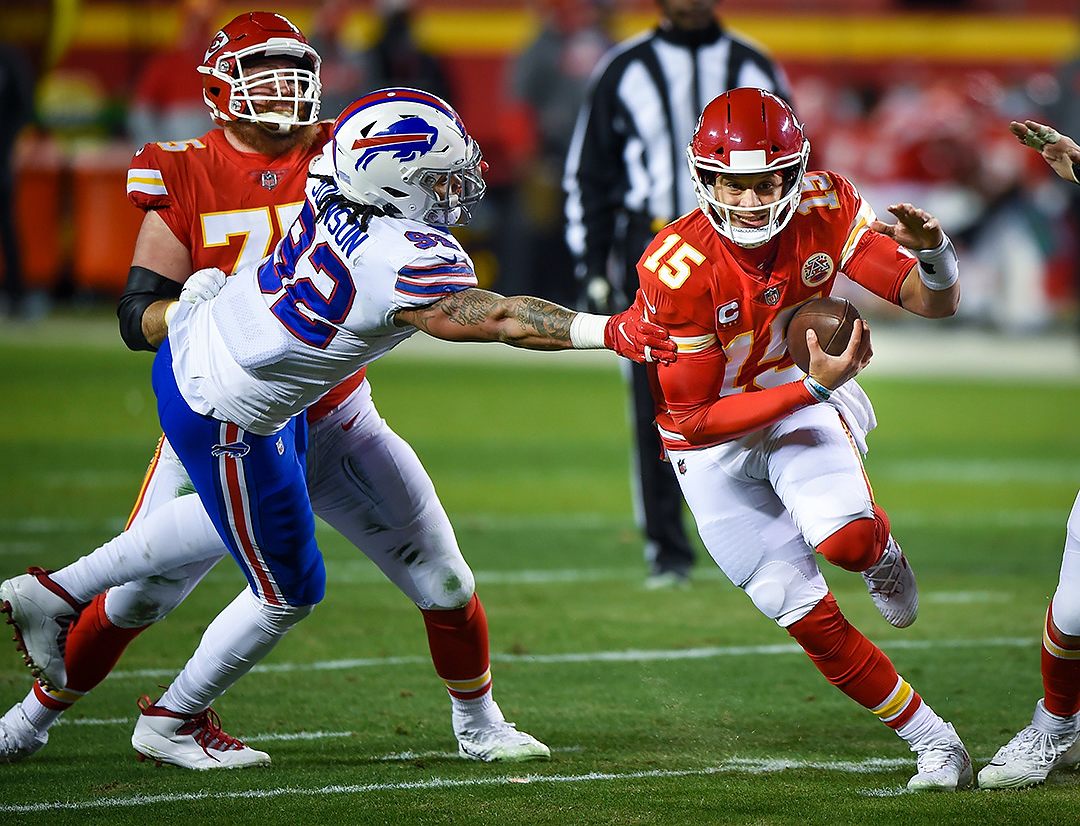
Buffalo Bills defensive end Darryl Johnson goes after Kansas City Chiefs quarterback Patrick Mahomes. Photo by Tammy Ljungblad/Kansas City Star.
“I shoot with back-button focus in Continuous Servo (AF-C) mode with the Group AF Area Mode setting. Using back-button with AF-C allows for continuous focus tracking of players, but also gives me easy composition control.” In other words, when there’s action, she simply holds down the AF-On button on the back of the camera and the autofocus system tracks the movement. If, however, she wants to photograph a coach on the sidelines or fans in the stands, she presses it, then after it finds focus, releases the button to leave the focus locked at that point. Now she can change her composition without worrying about the focus shifting.
She also uses the AF Fine-tune adjustment to compensate for older lenses that may have had years of hard use.
Also a photographer for the Kansas City Star, Jill Toyoshiba wears many hats in that job, telling stories through video as well as stills, in addition to being a licensed drone pilot. She too has been covering the Chiefs for the Star since last season, including a trip to the Super Bowl. This is what Jill’s been using this season:
Nikon D4S and Nikkor 400mm f/2.8 lens with a TC1.4X teleconverter.
Nikon D500 with 70-200mm f/2.8 lens.
Jill says, “The camera is set to AF-C (continuous autofocus) and Dynamic 51 AF Area Mode. I move the autofocus point around with the large round toggle button on the back of the camera. At some point I do want to try using Group AF. And I use the back button to engage autofocus (back-button focus).”
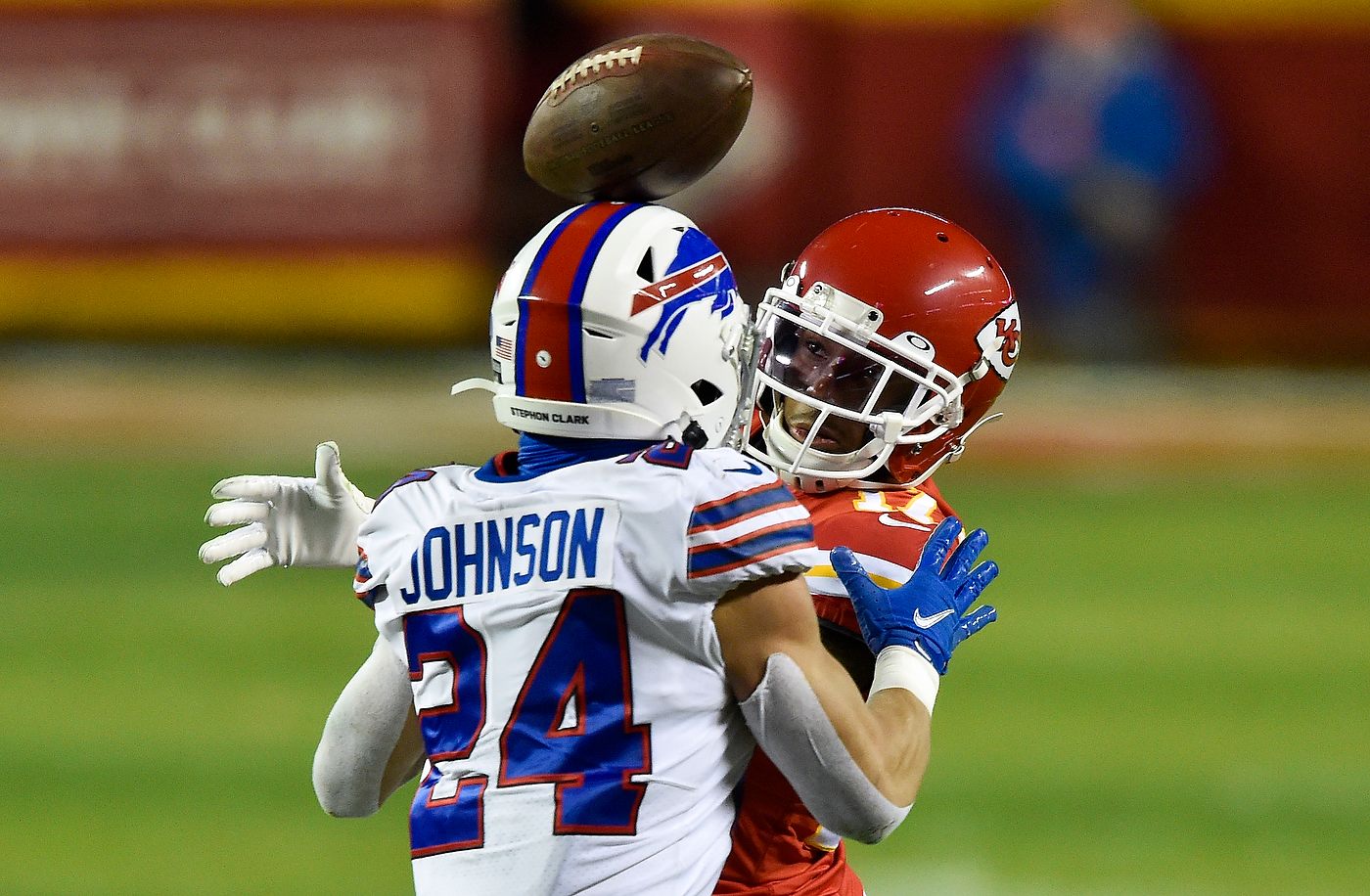
A pass intended for Kansas City Chiefs wide receiver Mecole Hardman bounces off the helmet of Buffalo Bills cornerback Taron Johnson. Photo by Jill Toyoshiba/Kansas City Star.
Tammy and Jill were joined for the playoffs by fellow Star photographer Rich Sugg. You can view a gallery of their photos from the AFC Championship here.
The Associated Press has several staff photographers in the area, and the two who’ve covered the Chiefs games throughout this season are Charlie Riedel and Jeff Roberson. Both shoot a lot of sports for the AP, across the U.S. as well as some international events like the Olympics. The AP recently traded out their Canon equipment for Sony, and both Charlie and Jeff admit they’re still learning the ins and outs of the new system. In normal times they’d have a runner collecting cards and taking them to a room off the field where an editor would then download, caption and transmit. But this season, due to COVID, there’s no runner, no room off the field and no editor, so they transmit from their cameras to an editor working outside of Kansas City (that did change for the playoffs). They do that by connecting to ethernet cables the Chiefs installed in the first row of the stands, where photographers now shoot from. To help the editor caption those photos accurately, Charlie and Jeff take advantage of their cameras’ ability to add a “voice tag” (short audio recording) that goes along with the image.
Based in St. Louis, Jeff hits the road for Chiefs home games, making the 4-hr drive back and forth each weekend. Here’s what Jeff has to say about his gear:
“I’ve been using three cameras for football this season, two Sony a9II’s and an a7RIII. Early on I played around with various lenses and autofocus settings before settling on a few that work best for me. The Sony teleconverters are incredibly sharp so I’ve been using them heavily. For example, I’ve been using an a9II with a 400mm f2.8 as my main camera and using the 2X teleconverter quite a bit. I’ve been blown away by how sharp the 400 is with the doubler. This has been particularly helpful because we haven’t been allowed on the field this season and have been forced to work from the stands due to the pandemic.
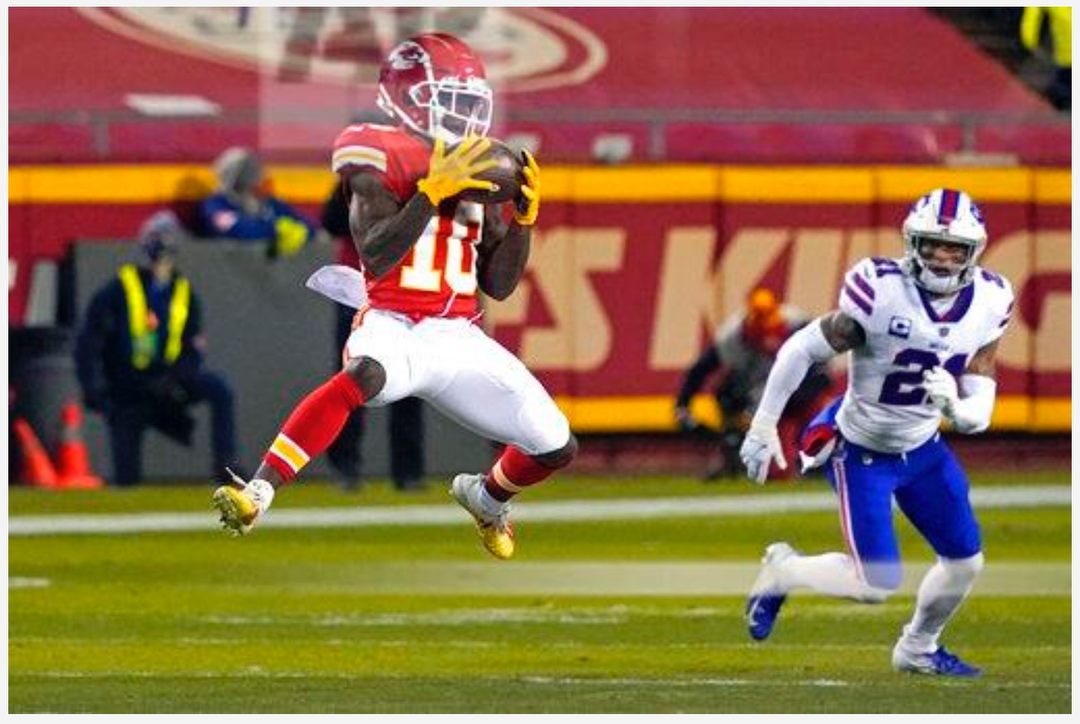
Kansas City Chiefs wide receiver Tyreek Hill makes a catch in front of Buffalo Bills safety Jordan Poyer. Screengrab from AP website – photo by Jeff Roberson/AP.
I’ve found that I really like using the 1.4X teleconverter on my second body with the 70-200 f2.8. Once we get back on the field I may abandon this approach, but I’ve found that using the teleconverter on that lens works well while shooting from the stands. I tried using the 100-400 f4.5-5.6 on my second camera but I prefer the 70-200 with the converter because that way I can shoot at a constant f/4 aperture (as opposed to the 100-400’s variable f/4.5-5.6).” Lastly, I’ve been using the 24-70 on the a7RIII as my “bailout” camera (when action comes unexpectedly close). This camera hasn’t gotten much use this season but when you need it, you need it.”
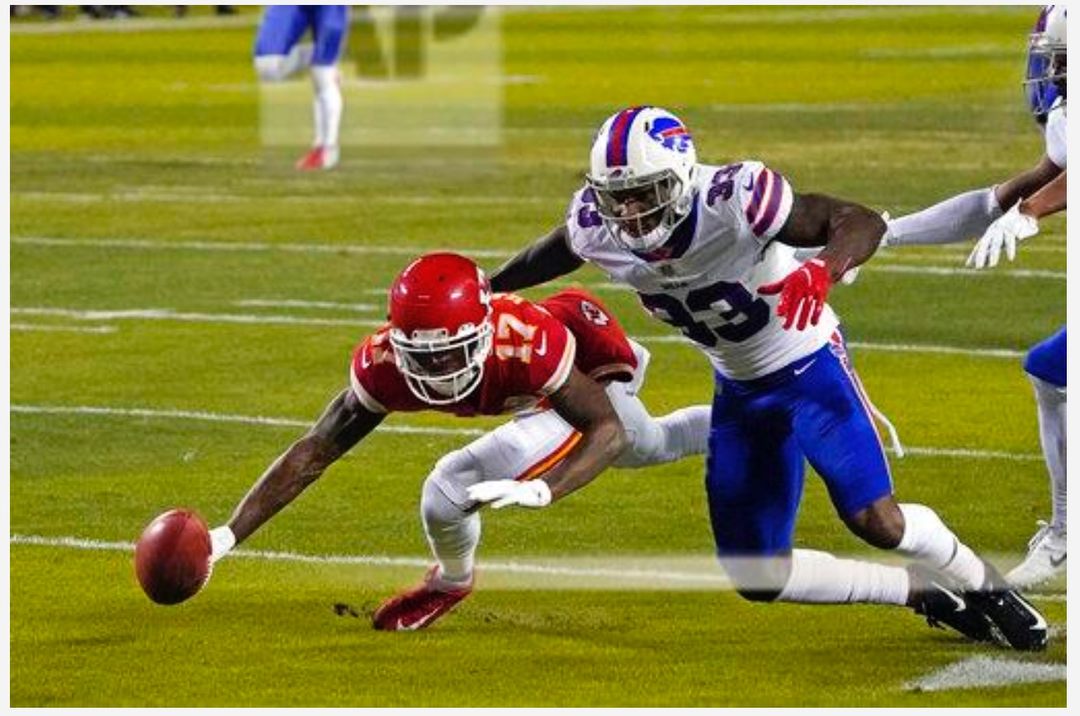
Kansas City Chiefs wide receiver Mecole Hardman fumbles a punt as Buffalo Bills cornerback Siran Neal tries to recover it. Screengrab from AP website – photo by Jeff Roberson/AP.
“The Sonys offer a dizzying array of auto focus choices and settings. Perhaps a few too many. I’ve found they all work pretty well and will switch them up depending on the situation, but I’ve settled on a few favorite go-to settings. For the most part I’ve been using the Center Focus Area. I’ve found it gives me the best overall control. I really liked using the Flexible Spot setting when I shot with Canon, but I’ve found that the joystick on the Sony is too easily moved and more often than not the focus point would not be where I expected when I brought the camera up to my eye to shoot when using this setting. You can do a quick double press on the joystick to get the point back to the center but that could take half a second, and in sports, if you have to wait half a second you’ve probably missed the shot. So I’ve found that using Center Focus Area works best for me. I use the same setting for my second camera with the 70-200 (and teleconverter) as well.”
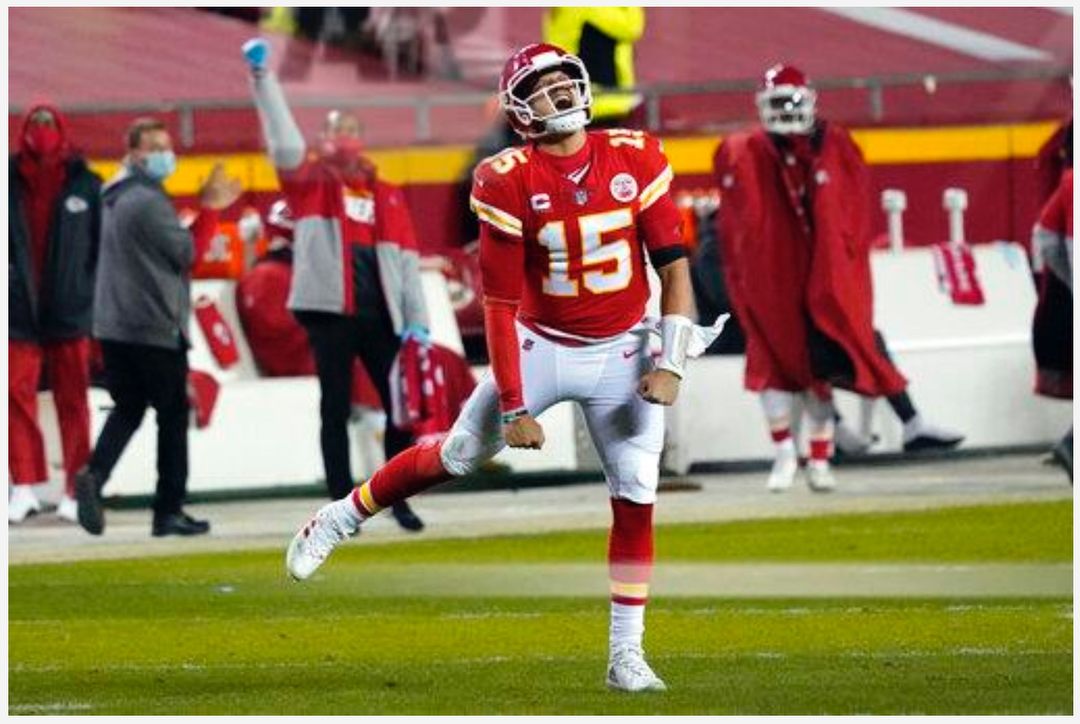
Kansas City Chiefs quarterback Patrick Mahomes reacts after throwing a touchdown against the Buffalo Bills. Screengrab from AP website – photo by Jeff Roberson/AP.
“I always us AF-C. I don’t see a reason to use anything else. I also almost always use the AF-On button to focus the camera (back-button focus). This way I’m able to control when the autofocus is active, giving me more control over what subject is in focus. An exception to using the back button would be my third camera, with the 24-70mm lens. Often times, I’m grabbing this camera quickly and shooting without the camera up to my eye. Because of this I use the Wide Focus Area and set the shutter button to activate focus. I’ve found this gives me the best chance of success because I’m often not even looking through the viewfinder when using this camera.”
You can see more of Jeff’s photos on the AP website.
Jeff’s partner through the season at Chiefs home games was Charlie Riedel. Charlie made a name for himself winning national awards as a photographer for a small newspaper in central Kansas, the Hays Daily News. The Associated Press took notice, and in 2000 hired him to work for them out of Kansas City. Since then, in addition to area assignments, he’s been sent to many, many national and international sporting events.
For Chiefs games, Charlie is using two Sony A9II bodies. He pairs one with a Sony 600mm f/4 lens (usually with a 1.4X teleconverter but sometimes with a 2X). He keeps the other body on a Sony 100-400mm f/5.6 lens.

Kansas City Chiefs cornerback Rashad Fenton intercepts a pass intended for Buffalo Bills wide receiver John Brown. Screengrab from AP website – photo by Charlie Riedel/AP.
Using the Auto ISO feature, he sets the minimum shutter speed to 1/2000th of a second at whatever the fastest f-stop the lens has (usually 5.6). For autofocus settings, in addition to AF-C (continuous), he likes using Flexible Spot (Medium). He also reduces the AF tracking sensitivity from 4 to 2, “to help keep the focus point from jumping around too much.” And he too uses back-button focus. You can view Charlie’s photos on the AP website as well.

Kansas City Chiefs tight end Travis Kelce tries to break the tackle of Buffalo Bills linebacker Tremaine Edmunds. Screengrab from AP website – photo by Charlie Riedel/AP.
Charlie and Jeff are both scheduled to cover baseball’s spring training, but as with most things in this world, they’re waiting to see how COVID affects that. After that, they’re – hopefully – off to the Olympics in Tokyo.
Finally, while I’ve covered the NFL since 1980, this year was very different for me. Before the season started, I got a call from Associated Press Images asking if I was available to do commercial work for them at the Chiefs home games. Instead of following the ball, my assignment would be to make “clean, isolated” action photos of individual players. Secondary was to find them on the sidelines without helmets, and then also photograph officials, signage, and many other things that go into an NFL game aside from action. When covering action alone, I tend to shoot horizontal with a long telephoto zoom, like a 200-400mm f/4. With this assignment, though, I spent the games mostly behind my Nikon D780 and 500mm f/4 (sometimes with a 1.4X teleconverter), shooting verticals and focusing not just on the marquee players – like quarterbacks, receivers and running backs – but linemen and defensive backs as well. It was a big change for me, and meant I was constantly on the move around the field.
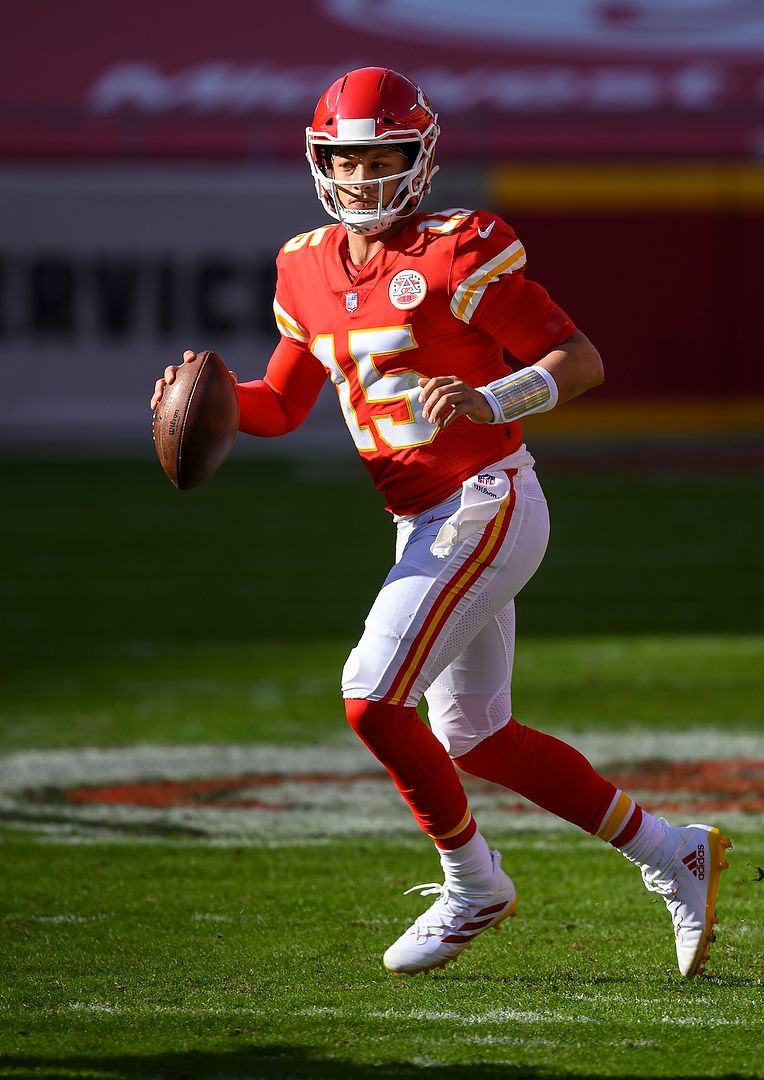
This is the exactly the kind of photo AP Images wanted from me during the regular season. Photo by Reed Hoffmann/AP. Nikon D780, Aperture Priority, Sunny white balance, ISO 280, 1/1600 at f/4 in Matrix metering, 0.0 EV, Nikkor VR 500mm f/4G lens.
At the end of the regular season though, AP asked me to switch and shoot editorial, which meant following the action. So for the two playoff games here, I worked with Jeff, Charlie and Orlin Wagner (another AP staffer in the area). Working as part of a team also changed where I shot from, as the four of us were each assigned a corner of the field. While Jamie (first photographer in this story), as the only Getty photographer, was often on the move around the first row of the stands chasing the action, the rest of us in this story were working as teams. Each of us had an area of the field we were responsible for. That meant less running around, but also a lot of watching action happen at the far end of the field. While we could still shoot it with our long lenses, the photos weren’t as good as when you’re closer.

Kansas City Chiefs tight end Travis Kelce and teammate Tyreek Hill celebrate Kelce’s touchdown catch against the Buffalo Bills. Of the six touchdowns scored in this game, only one happened at my end of the field. By having a photographer in each corner of the field, the Associated Press is sure to have photos from every important moment of the game . Photo by Reed Hoffmann/AP. Nikon D780, Aperture Priority, Preset white balance, ISO 3200, 1/1600 at f/4, Nikkor 70-200mm lens with TC-14e III teleconverter.
For the playoffs, my main camera was my Nikon D500 paired with my Nikkor 200-400mm f/4 lens. That gave me a 1.5X “crop” factor with the DX chip, meaning I’d have needed a 300-600 for the same angle of view on a full-frame camera. My second camera was a Nikon D780 with Nikkor 70-200mm f/2.8 lens and 1.4X teleconverter, giving me a focal length range of 105-300mm at f/4. Autofocus settings were the same on both cameras: AF-C, back-button focus and Group autofocus area mode. Like Charlie, I used Auto ISO to maintain a minimum shutter speed, choosing 1/1600 second, and allowing the ISO on the D500 to go up to 4000 and on the D780 up to 8000. Since neither of my cameras can transmit images from the camera (other than to my phone), I ran my cards up to the concourse, to a room that was set up for the playoffs. I did get my steps in Sunday night! You can see my photos from that game, as well as from the commercial work throughout the season, on the AP website here.

Kansas City Chiefs quarterback Patrick Mahomes celebrates as time runs out during their AFC championship over the Buffalo Bills. My corner of the field was on the Chiefs’ sideline, and that end is where the game ended, so it put me in a good position for celebration. Photo by Reed Hoffmann/AP. Nikon D500, Manual exposure, Preset white balance, ISO 1250 at f/4, Nikkor 200-400mm f/4 lens.
So, this story “focused” on how six different photographers worked a high-end sporting event, using three different camera brands and multiple different models. What’s important, though, is what they all had in common. High-end cameras and long lenses, plus deep knowledge, based on experience, of how best to control their autofocus systems. They all used back-button focus, choosing either a small group or a single sensor to track action. Despite all that, every one of them, if you asked, would tell you they’re still learning, making adjustments to how they work based on what they continue to learn and the new features their cameras offer. That’s the key takeaway for anyone reading this. If you think you know everything about your camera system and photography, you’re fooling yourself. One of the many great things about photography is that it can be a lifelong learning opportunity, at least for those who want to get better. That’s as true for the pros as for anyone else. As Charlie says, “It’s a work in progress.”
(Want to be automatically notified each time I post a new story? You can subscribe to this blog on my home page. And if you like this story, please share it with your friends and let them know about the links on photography that I post on my business Facebook page. I’m also on Instagram and Twitter, @reedhoffmann. And if you’re curious about the workshops I teach, you can find them here)


Thanks, Reed, for the great rundown. My action photography is limited to birds these days but a lot of helpful information in your post.
Thanks Brian, I’ve been doing a fair bit of bird photography too since COVID shut down my travel workshops. We get loads of eagles at a wildlife refuge north of here each December, and about a million snow geese in another month or so. The playoffs were a great opportunity for me to find out what works for other photographers. Always good to listen to others!
Thanks Reed. Great story! …and glad you got those steps in!
Congrats on the chiefs win and going to the
Super Bowl. Great information along with the great shots.
Curious why you used the D 780 instead of your
D850? Will you also be going to Tampa for the AP.
Thanks
Hi Byrl. I no longer have a D850, but even if I did, I’d choose the D780 for it’s better high ISO capability. Fewer and larger pixels, you know, and for a night game, I’d need high ISO. And no, no Tampa trip for mee, I’ll get to enjoy the game from the comfort of my sofa :).